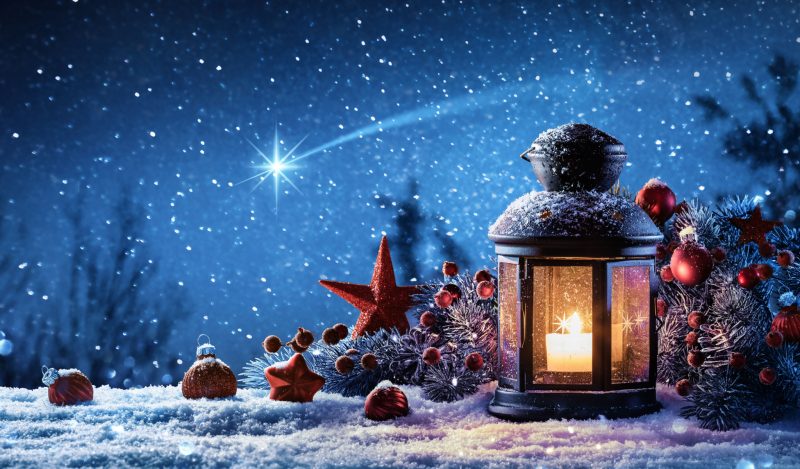The thing is, I remember Christmas.
I mean, real Christmas.
I was born in 1962. Which means that by 1966 or 1967 or so…I was aware that something magical happened to the world, at least to our world in America, in the middle of Winter.
By the time I was in kindergarten, I had some names for what was happening all around me at these wonderful times, and I grasped the basic story outline.
All at once, it seemed, drab interiors — the grocery store, with its beige linoleum flooring and its sad walls; the institutional-green halls of my elementary school; the butcher’s shop window, which previously had only sausages and veal chops on bland display; the window of the hardware store, which had til then showcased just unremarkable containers of grout, and drill bits, and cans of paint — indeed, the intersections themselves, which before then could not have been less interesting — suddenly all erupted in a three-dimensional froth of sparkle and shine, joyous images, and radiant color.
Does anyone else remember the Christmas displays of the 1960s? Made of colored cardboard, and perhaps aluminum of some kind, or tin, and adorned with tinsel of all variations; these wall decorations, as I recall, unfolded; and could be taped or draped or hung.
And thus in a heartbeat, you had a giant smiling Santa — not scary, not ironic, not drunk; just Santa, with the red cheeks and the big grin and the fluffy white beard. You had waving fronds of yellow-golden tinsel, and of bright green tinsel, and you had red tinsel that was always the color of a candy apple or a fire truck. You had gigantic sleigh bells — two of them always, friendly and collegial, tied with a plaid bow; you had cutouts of red sleighs piled with gifts. The shop windows reveled in sparkly spray-paint that proclaimed “Merry Christmas!” Or the mottos spelled out: “PEACE ON EARTH.” The intersections themselves revealed white tinsel decor of cross-like four-pointed stars….on street after street after street hung star after star after star.
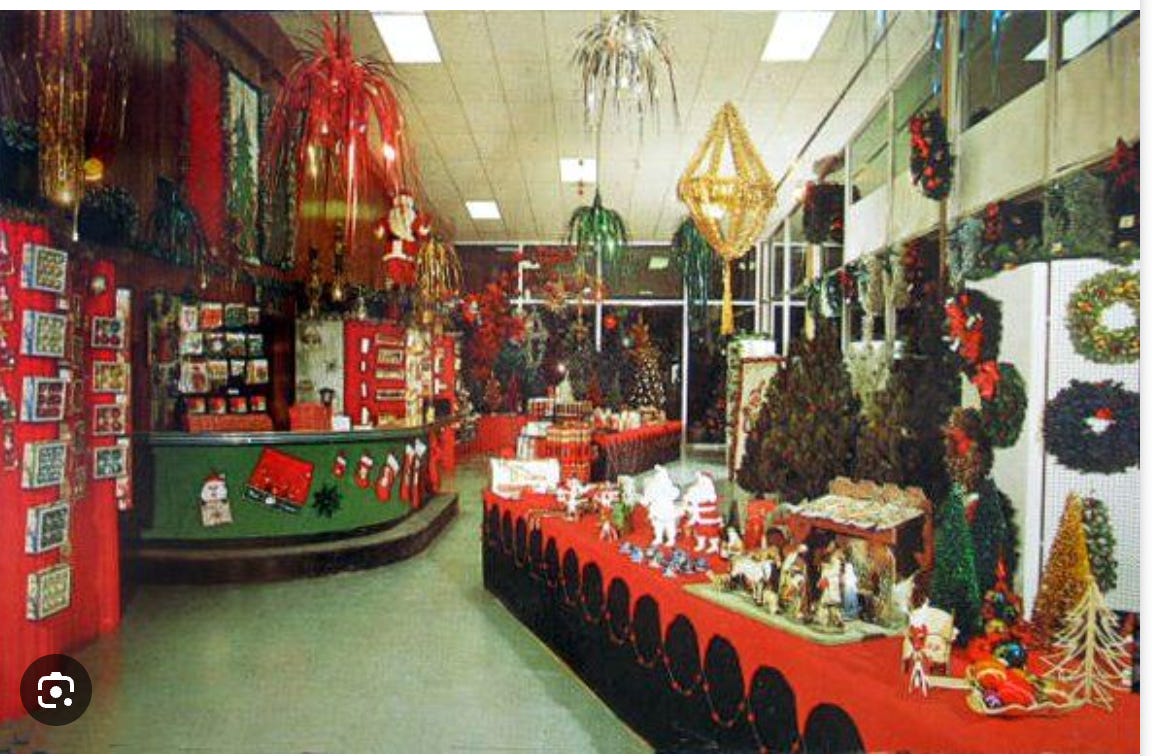

And there were creches. I loved them. Loved them. These were also called, once upon a time, “Nativity Scenes.”
Creches abounded at Christmastime in the 1960s. Yes, even in California.
There were tiny creches in candy store windows, next to piles of gilded packages of chocolates. There were creches outside of churches; these stood about four feet tall. What a transformation of the everyday world they represented — a world that even at five and six, I could see was stressful and sometimes boring and hurtful, especially to adults.
How extraordinary for a child to see a whole world about as high as that child, and as broad as a small car, like a Barbie playhouse but larger and serious and open; and to see that inside that world was a beautiful mom, and a gentle older dad with a staff, and camels and cows and sheep; and shepherds. In the center of it all was a baby, of whom it was said all around me that he was also king of the world; and that we were celebrating his birthday.
There were angels, and three mortal kings in regal, heavy, embroidered robes, bearing gifts. Gold. Frankincense. Myrrh. I wondered at this list, and remember asking my mother, “What is ‘frankincense’?” When she explained, I was enchanted that a story that was being told all around me, had a precious fragrance at its heart — a fragrance that was, not-usefully, a gift for a small baby.
It was all crazy and sort of nonsensical; but also, on the level of both the logic and the practice where angels live, it all made the most perfect sense.
The Christmas world of the 1960s was also made transcendental by the sudden presence of Christmas carols everywhere. These were mostly religious, though I did not think of them as “religious Christmas carols,” but rather as “Christmas carols”, because the holiday itself was obviously religious.
“Come, All Ye Faithful.” “Angels We Have Heard on High.” “Joy to the World.” “We Three Kings of Orient Are.” The music was played everywhere, with all kinds of instrumentation; but you heard it in drug stores, in department stores, in the homes of your friends. This elevated the mood, the vibration, if you will, of everywhere all at once; because sacred thoughts were being thought by thousands of people going about their otherwise ordinary days.
There was everywhere that warm glow you still feel sometimes in crowds on Valentine’s Day or Mother’s Day, as groups of humans together all think of someone whom they love.
But that glow then was more, and higher, somehow, than are these examples.
Also transformational was that the modern world, that usually listened to 1960s music, was listening to and even, when caroling, singing, melodies and words from the 17th and 18th and 19th centuries. This gave a sense of otherness and continuity and excitement to all that was around us, since our history was rich, and extended long into the past, and since we were experiencing openings into the sounds of other times, whose worship and joys extended to that very day.
But eventually— the Nativity scenes and plays, and the carols even, became “controversial.”
In the 1960s through to the 1970s and into the early 1980s, Christmas movies still had messages of hope, family togetherness, redemption and love.
I noticed in the 1980s, when I was a young college and graduate student, that Christmas still carried that high, that sacred quality. But over time I felt the “Christmas Spirit” eroding and dying.
I noticed that pop culture was adding a whole new cast of personalities to Christmas, exalting them, but dialing down others. “Peanuts,” the cartoon series, had been openly spiritually-oriented in its treatment of the season; “A Charlie Brown Christmas” debuted in 1965.
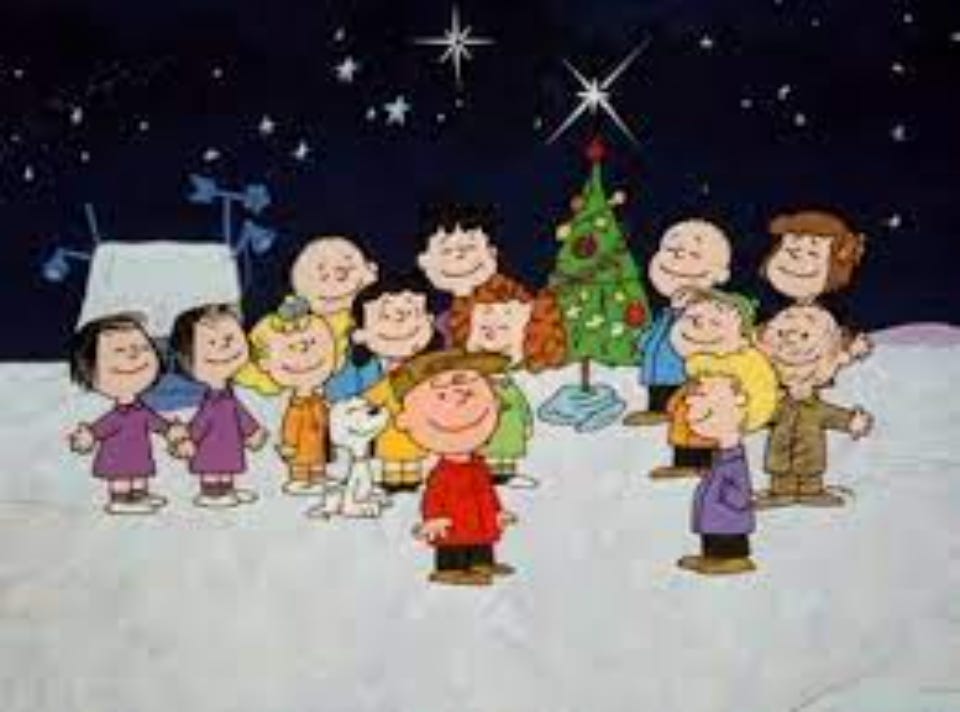

But “Peanuts” became less culturally central as the 1980s unfolded and the 1990s began. I loved Dr Seuss’ “How the Grinch Stole Christmas” (film, 1966), but that was a fairly new character popularized by the culture. The message was of love in general, but not specifically about that baby in the manger at all. The Whos down in Who-ville did not sing recognizable Christmas songs – -they sang a made-up Latin-sounding carol, “Dahoo Dores:”
Fahoo fores, dahoo dores
Welcome all who’s far and near
Welcome Christmas, fahoo ramus
Welcome Christmas, dahoo damus
Sweet, but with no discernible meaning. Rudolph the Red-Nosed Reindeer? This had been a minor character launched in 1939 in a song, but he now became central — super important. The reindeer, who had not even had widely-known names in my childhood, unless you hunted out the 1823 poem “The Night Before Christmas” — all were now familiarly named. Elves? Critical! Santa’s factory and the manufacturing process of toys? SO central! A Christmas Story, 1983, became the hallmark of that decade — it is nostalgic but is in no way religious.
All of these characters and side narratives are fun, but they are not actually about — Christmas; about the birth of the Christ child.
They are about other things. Inclusion, not discriminating on the basis of someone’s unusual snout, the making and distributing of consumer goods.
Then — in 1989, an important lawsuit deconstructed Christmas — and Hanukkah, for that matter —in America. In the lawsuit “County of Allegheny vs ACLU,” according to that organization’s website Oyez.com,
“Two public-sponsored holiday displays in Pittsburgh, Pennsylvania, were challenged by the American Civil Liberties Union. The first display involved a Christian nativity scene inside the Allegheny County Courthouse. The second display was a large Chanukah menorah, erected each year by the Chabad Jewish organization, outside the City-County building. The ACLU claimed the displays constituted state endorsement of religion. This case was decided together with Chabad v. ACLU and City of Pittsburgh v. ACLU of Greater Pittsburgh.”
I was surprised to read this, because in the yawning, ever-hungry abyss, where national memories that don’t fit “the narrative” go to die, the fact that the ACLU took aim in this famous case against the display of a public Menorah — as well as against a public Christian creche, which is widely known — has been lost to history. Those who want to share their Nativity scenes openly in public with their neighbors, are depicted in “the narrative” as thug-like Christian white supremacists. It’s been erased from American history that the people of Allegheny got in trouble with the ACLU for inviting their Jewish neighbors to share with the larger community the joy, pride, and symbolism of their minority-religion Hanukkah.
Indeed, this case, that changed America, is an odd one. It’s as weirdly decided as was Roe v. Wade.
According to the ACLU, the central question of the case was whether or not the two displays — remember: one Christian, one Jewish — violated the Establishment Clause of the First Amendment. This clause forbids the State from establishing a government-endorsed religion. The Court said that one symbol did, and one did not:
“In a 5-to-4 decision, the Court held that the creche inside the courthouse unmistakably endorsed Christianity in violation of the Establishment Clause. By prominently displaying the words “Glory to God for the birth of Jesus Christ,” the county sent a clear message that it supported and promoted Christian orthodoxy. The Court also held, however, that not all religious celebrations on government property violated the Establishment Clause. Six of the justices concluded that the display involving the menorah was constitutionally legitimate given its “particular physical setting”, reports the ACLU.
As a Jew, I find the reasoning in Allegheny vs ACLU to be odd. How is a Menorah outside the courthouse not establishing a religion, but a creche inside the courthouse, is doing so? I can see that a creche inside a courthouse would violate the Establishment clause; but the reasoning in this case was so heavy-handed and literal — why not move BOTH the creche and the Menorah outside the courthouse, and invite other religious displays? Or move them to a park or to outside the library? — that it crushed Christmas as a public occasion of collective joy, as well as Hanukkah, for the next 34 years.
Let’s look more closely at the Establishment Clause. What is it? According to the Legal Information Institute, a site funded by Cornell University:
“The First Amendment’s Establishment Clause prohibits the government from making any law “respecting an establishment of religion.” This clause not only forbids the government from establishing an official religion, but also prohibits government actions that unduly favor one religion over another. It also prohibits the government from unduly preferring religion over non-religion, or non-religion over religion.”
But — is that interpretation actually correct? Or is it an example of the migration of definitions that are proliferating everywhere these days, especially in relation to our history, our Constitution, and other key concepts of our national life?
Hm. Is China at war with our religious freedom — our freedom to worship — just as it is with our statues, our holidays, our patriotic symbols, and our core iconography?
In one click, we see that in 2019 Cornell University was investigated for accepting millions of dollars in gifts from China (and Qatar), and unlawfully not disclosing them to Federal officials. In addition to $65 million from Qatar — undisclosed to government agencies concerned about national security issues – – China made huge investments in the university, that also bypassed national security checks.
“Cornell has also received $12.5 million worth of contracts and gifts based in China. Over $5 million of that money was from contracts with Huawei, a technology company listed by the federal government as one that is denied sensitive technology because it is a danger to national security. The $5.3 million payment, spread over two research contracts […], was the largest payout to an American university in the last six years, the Cornell Sun reported.” China’s influence only grew in the next four years, and was deeply institutionalized. In December 2022, the Cornell Faculty Senate called for the “disentanglement” of Cornell University from its Chinese partners, from whom it was generating millions in revenue; the school had launched a joint offerings in its famous hospitality program, and had launched a “global hub” with China as a partner.
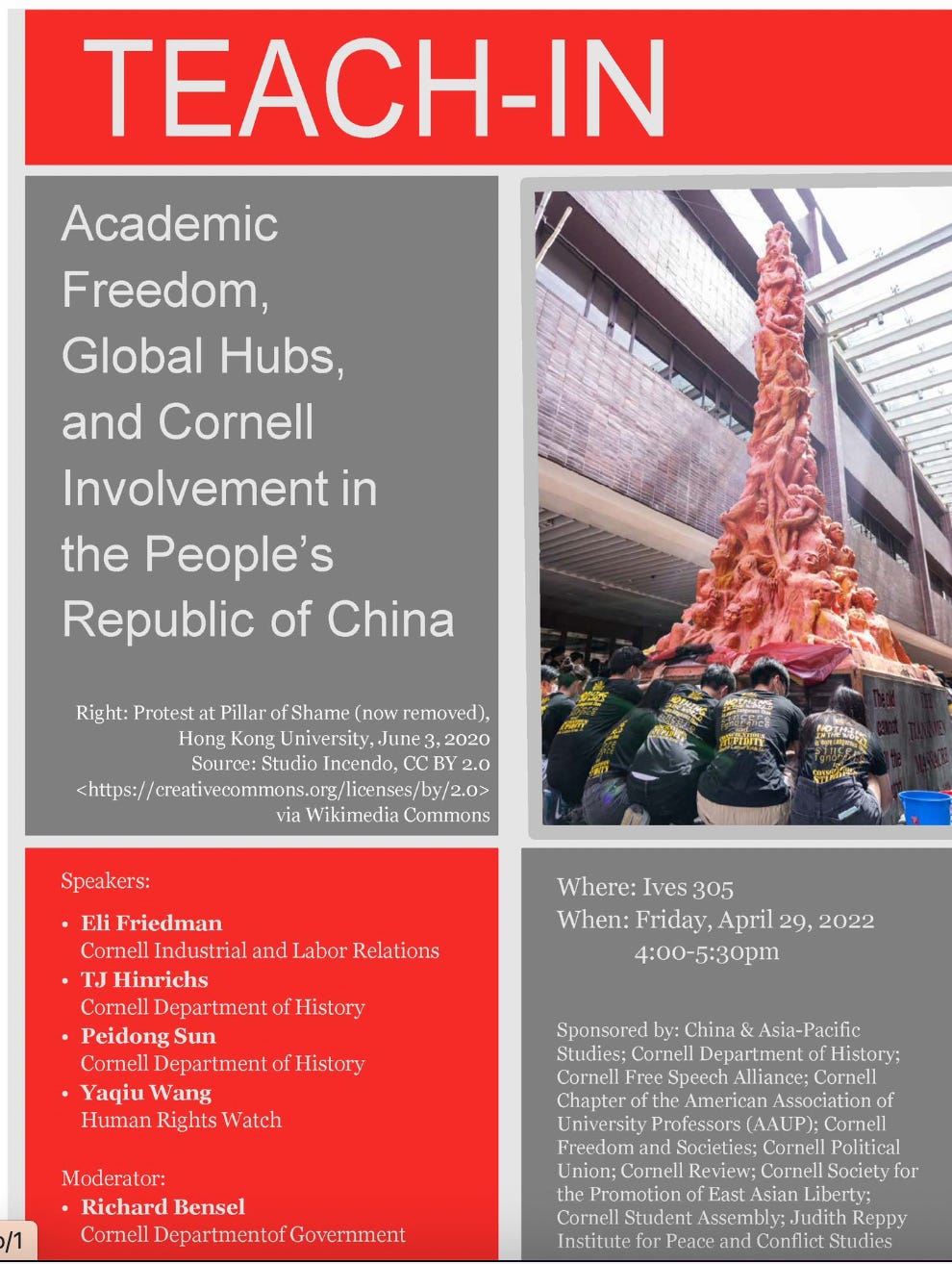

This is just one Ivy League university, but the money flow to just this university shows that actual Marxists may have a powerful hand in the twisting of legal definitions related to our Constitution, that that university is producing for the world.
So, ignoring the diffused, tendentious, anti-religious expression definition in the (Marxist-funded)-Cornell University-funded website, let us go to the primary text. What is the text of the Establishment Clause, while we can still access it?
“Congress shall make no law respecting an establishment of religion, or prohibiting the free exercise thereof; or abridging the freedom of speech, or of the press; or the right of the people peaceably to assemble, and to petition the Government for a redress of grievances.”
But — is displaying a creche outside a public building, along with other religious symbols and images as the community chooses, the same as Congress “mak[ing a] law” respecting an establishment of religion? Does it prevent people from freely exercising their religions? Or is it actually an example of people freely exercising their religion, which is what the actual wording of the Establishment Clause seeks to protect?
I would say that the people of Allegheny actually had it mostly right, per the Constitution, and should have moved the local Nativity scene outdoors proudly to join the local Menorah, rather than having had to spend taxpayer dollars defending themselves from the ravening ACLU, and the too-broad sweep of the ruling of the Court.
Paradoxically, the people of Allegheny’s openness to Americans’ multiple, free, open expressions of worship, is exactly what the Establishment Clause is meant to protect. Our Constitution does not say anywhere, and certainly not in the Establishment Clause, that we must hide symbols of our various religious expressions. It says the opposite.
Though different courts would decide in different ways on how or if religion should feature in public life, the chill this decision cast on any sharing of Christmas as a joyful religious occasion, or Hanukkah for that matter, was absolute.
Who wants to cross the line and get sued by the ACLU? Or by a neighbor?
I remember the media coverage of this case. Newsweeklies reported it as if: thank God, the ACLU had saved America from being ravished by screaming Bible-thumpers. There was little questioning of what this decision would do to us, or even if it was a correct interpretation by the court.
So overnight, it seemed to me, people reacted, understandably enough, by scrubbing the religious expressions of the holidays.
The playlist in stores at Christmastime changed. All the religious carols? They vanished like melted snow. In came pop-y, bouncy tunes that have “become classics”, but that are also not — actually about Christmas. Some of them are slightly louche.
Older popular songs were also resurrected as religious carols were retired. “Baby, It’s Cold Outside,” a 1944 melody about snowfall and seduction, got re-popularized (then in 2004 a “controversy” claiming that it is “an ode to statutory rape” took down that one in turn). The 1952 song “I Saw Mama Kissing Santa Claus” was re-covered by contemporary artists — and it’s about, well, hints of adultery with the guy who had been so genial and family-friendly:
Then I saw Mommy tickle Santa Claus (tickle, tickle, Santa Claus)
Underneath his beard so snowy white
Oh, what a laugh it would have been
If daddy had only seen
Mommy kissing Santa Claus last night
What child is not going to be made anxious by this scenario? It’s not a little creepy.
Then we had “Last Christmas, I Gave You My Heart” — a 1984 song by “Wham!” about romantic loss. The 1957 “Jingle Bell Rock” also had a revival. It’s about dancing.
Finally a new character took center stage — not baby Jesus, or even the Maccabees, for that matter, but — winter: the dreaming of a “White Christmas” — Jack Frost nipping at your nose — the dashing through the snow. As all of those mid-century ballads were revived, and all the religious carols were sent into that abyss of cultural memory, the season itself became the central story of Christmas — and the baby was, well, faint, hard to discern, almost gone.
In the 2000s, a new wave of cultural change is targeting what little is left of the warm memory of the season, and erasing entirely the story of that baby’s birth, from Western culture. The Daily Mail reported in 2020 that half of Britain’s schools had cancelled Nativity plays — surely the breaking of the chain of memory among generations of British schoolchildren. This breaking of the chain between generations of children, was one goal of the “lockdowns,” a point I made generally in my book The Bodies of Others. The Daily Mail reports now that Nativity plays in schools are being “repackaged” to refer to pop TV shows, such as The Great British Bake Off, and to celebrities, instead of following the traditional Nativity scripts handed down for decades.
Alarmingly, when I searched “Daily Mail” and “Nativity Plays No More,” I saw that stories about schools banning Nativity plays, or barring parents from attending their own children’s Nativity plays, go back to 2012, with a drumbeat of escalation in recent years. This is the drip, drip, drip of water intentional set slowly to boil — of deliberate cultural change.
Of course, you know where this is going, because Marxists do not like families, just as they don’t like religion. Schools in England now banned parents from attending their own children’s Nativity plays. Due to? Colds, flus, and COVID. The State has finally taken your child, and your Christmas, away.
What else debuted by the 20-teens? A range of new Christmas movies that depicted cherished Christmas symbolism as tawdry, drunk, or sexually licentious. There was the 2014 film Bad Santa, with Billy Bob Thornton.
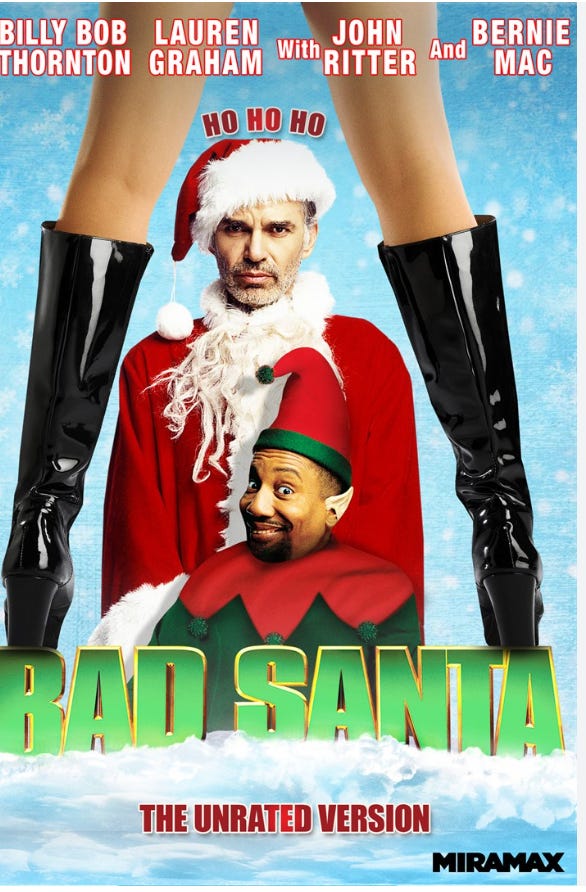

There is 2022’s It’s a Wonderful Binge, a send-up of Christmas classics such as It’s a Wonderful Life; but in this Holiday movie, “St Nick” is “inebriated” and the setting is a world in which all alcohol is banned, so Christmas represents the one time to binge on intoxicants.
“In this first trailer for It’s A Wonderful Binge — the forthcoming sequel to 2020’s The Binge — its revealed that the recklessly wild event has inexplicably been moved by the government to Christmas Eve, and the drugs and booze are flowing freely.”
And finally there is SantaCon – which seems like a cute idea, at least superficially. It launched in 2011, the decade in which all the public Santas first went bad. It is a mass gathering of people dressed like Santa (or like elves; and now pandas have debuted — echoes of China’s cultural intervention in our world, anyone?). The Santas — and now elves, and pandas — storm cities drinking steadily in various bars. By the end of SantaCon, thus, little children (this happened to our family) get to witness Santas vomiting at scale in the street, or engaging in corny super-drunk public sex jokes.
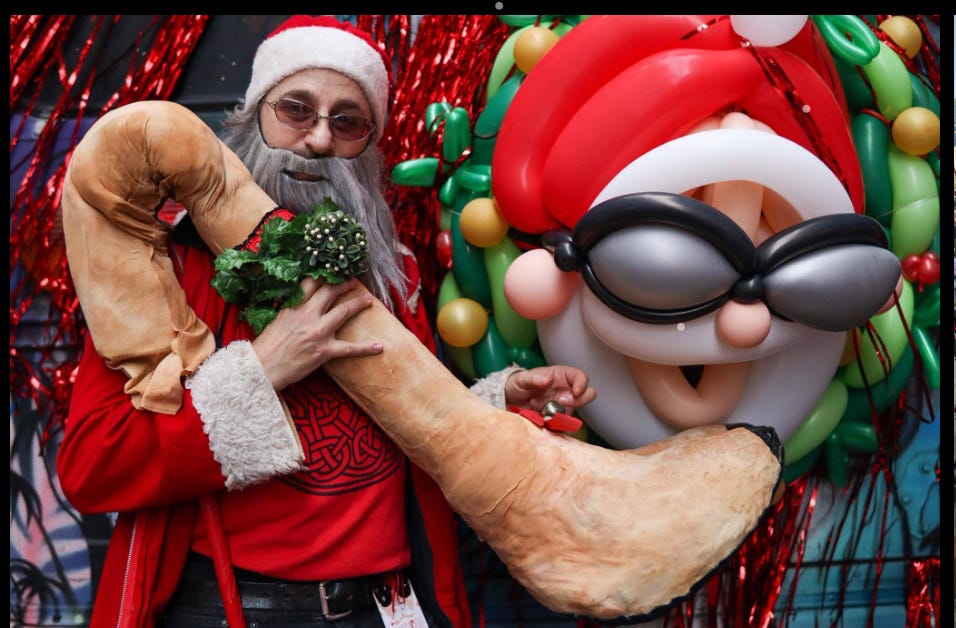

I could go on, but there you are. It’s a slow war.
I remember the purity, the clarity of the energies around us all at Christmases before this war.
How people would grow more gentle; how their faces would soften as they counted out change for a customer at a grocery store. “Merry Christmas!” we would call to one another. Who cares what religion we were? It was Christmas for all of us. No one owned Christmas.
How could the energies around us not have purified, softened, and uplifted us all? I’ve shared how aware I was of “energies” as a child, and even, I am sometimes sorry to admit, to this day. I realized when I was five, that the Christmas Spirit was called forth by the thoughts of the people.
How could all of those people thinking all day, consciously or not, of a baby who had been born to save the world from itself — of a holy star sent to guide us even in the middle of the darkest part of our winter — of animals and strangers and kings recognizing that someone so small and vulnerable had been sent in fact to rescue us — not have made for the Christmas miracle?
How could all of those thoughts, not have made us all kinder, sweeter, more hopeful?
I remember in January, when the trees were thrown out onto the streets, naked now, and the decorations were taken down, that the sour mood of adults in ordinary life returned to the world. Christmas was over.
And I would wonder at this, because I understood what I had lived through in December. “Didn’t they realize?” I asked myself as I watched. Christmas never had to be over.
It was up to them.
Didn’t they understand that the magic was not just something that came and went…it was not caused by the decorations or the gifts; didn’t they understand that they had created the magic? Did they not realize that they had accomplished this feat by thinking those sweet thoughts —- by singing those uplifting songs — by elevating their attention — together?
No; — year after year, the adults took down the decorations, and it was over; and they did not realize that Christmas never needed to end.
Lastly, I want to speak to this dangerous notion — emblematized by the metastasis of “Merry Christmas!” to the fearful, euphemistic “Happy Holidays!” — that your Christmas, your proud, happy, eager, delighted, full-blown public Christmas, somehow offends or erases me, a non-Christian.
This notion — that one’s sense of self is so fragile that others’ cultural or religious expression alone can damage it — is the neo-Marxist theoretical basis for the wholesale targeting of Western culture, as I have said before.
When I was a child, I never felt that the overt, uncensored, exuberant celebration of Christmas, by the Christians around me, diminished Jewish little me, one bit.
I felt enriched by it.
I knew I was a Jewish child, and that this was not our holiday. So what?
I got to have the happiness and wonder of watching it all, and of sharing in the warmth of it; we did not need to be Christian — we did not need to have a tree at home or to open Christmas presents — to get joy from the religious expression of others.
I got to learn about a story of hope and redemption; about a society that was changed when mortal kings bowed down to a baby; kings who had visited a poor woman who herself could find no room in an inn.
Those were not just Christian values. They were Western values. They thus included me, and I knew it. That story was part of my story, as a Western child, and I got to inherit pride in those values too.
If anything, experiencing and reveling in these differences among my friends and classmates, strengthened my identity as a Jewish child. I learned what I was not, and I also learned what I was. How does others’ culture or religious expression “erase” an identity? Identities are not like drops of water, so fragile that they lose all shape when anything touches them.
We had our own thing, and it was awesome too. Christian friends who learned about Hanukkah got the chance to learn about other wonderful values from another extraordinary story that had influenced the West; about courage, about facing the greatest empire of the time and bringing it to heel against all odds, about miracles.
How would learning about the Hanukkah story make any Christian child less Christian, or offend anyone? We were sharing our values too. All of that sharing of religious difference, as our Founders knew in their wisdom, simply adds to America’s blessedness and richness.
This illogical, childish notion — that asserting a cultural or religious identity somehow by definition offends or diminishes or erases anyone else’s — has to be consigned to the garbage heap of history’s most pernicious ideas.
This premise will leave our culture a parking lot with a quarantine camp attached, as I have said before. And that is exactly its intention.
This premise is China’s and the WEF’s way of making us all ashamed of ourselves, so that we never have transcendence again — and so our kids have no idea what Western — or American — values, really are.
The WEF and China know what they are doing. Bring on the barfing Santas, and bring on the Christmas Pandas. Close the Nativity plays in British schools. Bring on the Great British Bake Off characters and the moment’s celebrities, instead.
And for heaven’s sake, don’t mention that little child who began it all.
How will children of any religion or background, raised on “binging Christmas” and vomiting Santas, almost ignorant of the story of a baby in a manger, really feel what Christmas really brings: this elevation in consciousness?
Eventually the Western religious celebrations of this season — that energy that redeems and saves us from the deepest, scariest winter — will be the faintest and most marginalized of memories, for the generations to come.
But no one will notice what is really happening, or understand — or care.
So let us fight these plans too that the demons of our era, have for us. ACLU vs Allegheny was decided wrongly.
We need to honor and remember the terms of our Constitution, and strengthen ourselves in our current life-and-death fight against the “globalist neo-Marxists,” by refusing to let our free expression of religion, be silenced.
Bring on the not-drunk Santas. Bring on the cookies. Release the carolers. Put the golden stars of the past, over the crosswalks. Raise up your giant menorahs.
Haul out your creches. Put them on your lawns. I won’t sue you.
Turn up “Hark the Herald Angels Sing.”
I am not offended at all. You make me richer, and I make you richer.
Whoever you are, however you worship, please honor our Founders by expressing your religion freely out in the open without fear in exactly the way you choose.
Friend — American — whoever you are,
Merry Christmas.
Republished from the author’s Substack
Join the conversation:


Published under a Creative Commons Attribution 4.0 International License
For reprints, please set the canonical link back to the original Brownstone Institute Article and Author.
